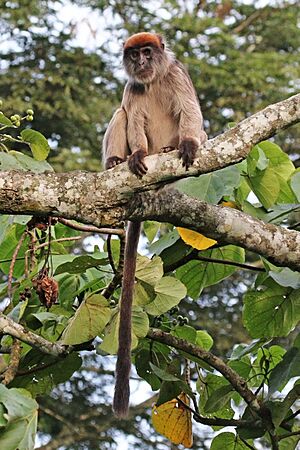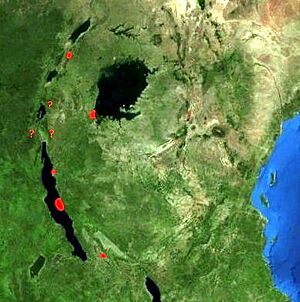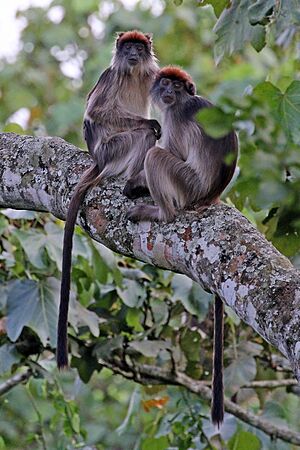Ugandan red colobus facts for kids
Quick facts for kids Ugandan red colobus |
|
|---|---|
 |
|
| Kihingami Wetlands, near Kibale Forest, Uganda | |
| Conservation status | |
| Scientific classification | |
| Genus: |
Piliocolobus
|
| Species: |
tephrosceles
|
 |
|
| Distribution of the Ugandan red colobus | |

The Ugandan red colobus (Piliocolobus tephrosceles) is a type of monkey. It is also called the ashy red colobus. This monkey is an endangered species, meaning it is at risk of disappearing forever. Scientists have recognized it as its own species since 2001.
Some scientists still debate if it should be called a separate species. They think it might be a subspecies of another red colobus monkey. The Ugandan red colobus is an Old World monkey. You can find it in five different places in Uganda and Tanzania.
Contents
About Ugandan Red Colobus Taxonomy
Scientists first officially recognized the Ugandan red colobus as its own species in 2001. Before that, it was thought to be a subspecies of other red colobus monkeys. For example, it was once considered part of the western red colobus or the Central African red colobus.
Today, there is still some discussion among scientists. They are trying to decide if it should be a subspecies of the Tana River red colobus. Taxonomy is the science of classifying living things. It helps us understand how different animals are related.
What Does the Ugandan Red Colobus Look Like?
The Ugandan red colobus has a rust-red cap on its head. Its face is dark gray to black. Baby colobus monkeys are born with completely black faces. Their body fur can be black, dark gray, or even reddish-brown.
The sides of their bodies, arms, and legs are light gray. They have very long, dark to light brown tails. These tails are super important for balance. They help the monkeys climb and leap through the trees. Their hands and feet are dark gray or black. Their long feet help them jump long distances.
Like all colobus monkeys, the Ugandan red colobus has very small thumbs. They are so tiny that they are almost gone! Scientists think this helps them swing easily through the tree branches. This way of moving is called brachiation.
Male Ugandan red colobus monkeys are much bigger than females. This difference in size between males and females is called sexual dimorphism. An average male weighs about 10.5 kilograms (23 pounds). Females are smaller, weighing around 7 kilograms (15 pounds).
Where Do Ugandan Red Colobus Monkeys Live?
The Ugandan red colobus lives only in Africa. Their homes are spread out over 1,000 kilometers (620 miles) in East Africa. However, you can only find groups of them in five separate forest areas. These areas include western Tanzania, near Lake Victoria. They also live in Gombe Stream National Park and Mahale Mountains near Lake Tanganyika. You can find them on the Ufipa Plateau and in Kibale National Park in western Uganda.
The largest group of these monkeys lives in Uganda. Scientists believe this is the only group big enough to survive long-term. There are about 17,000 monkeys in this group. It is possible that Ugandan red colobus monkeys also live in Rwanda, Burundi, and the eastern Democratic Republic of the Congo. However, this has not been confirmed yet.
The type of forest where they live can be different for each group. Kibale National Park in Uganda has the largest group. This park is a moist evergreen tropical forest. Kibale National Park has been a protected area since 1993. Before that, some parts of the forest were cut down for wood. In other places, like the Mbisi Forest Reserve, their homes are broken up and damaged.
How Do Ugandan Red Colobus Monkeys Behave?
What Do Ugandan Red Colobus Monkeys Eat?
The Ugandan red colobus is a folivore. This means that leaves are the main part of its diet. They are not picky about which tree species they eat. Different groups in the same forest might even prefer different types of trees.
While they eat many kinds of leaves, they especially like young leaves. They also enjoy the stems (called petioles) of older leaves. Sometimes, they eat bark, seeds, and fruits. These foods are rare for them but are important for getting extra nutrients.
How Do Ugandan Red Colobus Monkeys Live in Groups?
Ugandan red colobus monkeys live in groups with many males. The size of a group can change. It depends on how much food is available and how many predators are around. Groups can have as few as 3 monkeys or as many as 85. The average group size is about 40 monkeys.
The number of males often decides how big a group is. Males usually stay in the same group and rarely move to another. Females, however, can easily move to different groups. They are often drawn to groups that have more males. In all groups, there are more females than males. This natural difference is made even bigger by common chimpanzees. Chimpanzees often hunt female monkeys and young ones.
Within a group, there is a pecking order, or dominance hierarchy. Adult males are usually in charge over adult females. This is probably because the males are much bigger.
Ugandan red colobus groups often split into smaller groups to find food. This is called a fission-fusion society. It is helpful when there isn't much food, like in parts of the forest that have been cut down.
Grooming is a common way for monkeys to interact with each other. Females do most of the grooming. They groom males, young monkeys, and other females. Males groom less often. They also get groomed the most, unless they are lower in the group's pecking order.
How Do Ugandan Red Colobus Monkeys Interact with Other Animals?
The Ugandan red colobus often hangs out with other types of monkeys. In parts of Kibale National Park, they spend more than half their time with red-tailed monkeys. They also sometimes associate with gray-cheeked mangabeys, blue monkeys, and mantled guerezas.
Scientists are not completely sure why they form these mixed-species groups. But the most common idea is that it helps protect them from predators. When they are with red-tailed monkeys, the Ugandan red colobus monkeys watch out for predators less often. They also form these groups more often when there are many young monkeys in their group. This suggests that being with other species helps keep them safer.
Who Are the Predators of the Ugandan Red Colobus?
The Ugandan red colobus has two main predators: the common chimpanzee and the crowned eagle. Kibale National Park has many types of monkeys. But chimpanzees usually only hunt the Ugandan red colobus. In one area of Kibale, up to 12% of the red colobus population is killed by chimpanzees each year. Chimpanzees do not hunt them all year. Instead, they have periods of heavy hunting. When a chimpanzee attacks, all the red colobus monkeys in the group gather together. The males will try to scare away the chimpanzee.
Crowned eagles prefer to hunt baby and young Ugandan red colobus monkeys. Research shows that both the Ugandan red colobus and the red-tailed monkey are killed less often by crowned eagles than expected. This is surprising because there are so many of these monkeys in Kibale National Park. Scientists think that forming mixed-species groups helps both monkey species avoid being caught by eagles.
Ugandan Red Colobus Life Cycle
Male Ugandan red colobus monkeys become adults at 5 years old. Females become adults between 4 and 5 years old. A female monkey is pregnant for 5 to 6 months. They have their first baby when they are between 4 and 5 years old.
There is no special time of year when babies are born. Infants can be born all year round. However, more babies are born during the rainy months. This is because there are more new leaves for food during this time.
Both males and females can start the mating process. Sometimes, other monkeys in the group will bother the mating pair. They might make loud noises, lunge at them, or jump around them. These botherers are usually other adult males who want to mate. Sometimes, young monkeys will bother the pair if it is their mother who is mating.
Why Is the Ugandan Red Colobus Endangered?
The Ugandan red colobus is listed as Endangered on the IUCN Red List. This means they are at high risk of becoming extinct. They are endangered for a few reasons. Their groups are very spread out, and monkeys cannot move between these groups. This makes it hard for them to find new mates or new homes.
The total area where all these groups live is less than 5,000 square kilometers (1,930 square miles). This area is shrinking because their forest homes are being lost or damaged. This happens especially in areas that are not protected parks. The number of Ugandan red colobus monkeys is also going down. This is mainly because chimpanzees hunt them and because their homes are being destroyed. People do not usually hunt the Ugandan red colobus. In Kibale, Uganda, hunting of all monkeys stopped in the 1960s.
The Ugandan red colobus is also listed in Appendix II of CITES. This is an international agreement that helps control the trade of endangered animals.
Images for kids




